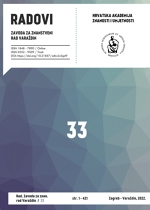PRILOG POZNAVANJU TRASE VIA MAGNA IZMEĐU VARAŽDINA I KRIŽEVACA
A CONTRIBUTION TO THE KNOWLEDGE OF THE VIA MAGNA ROUTE BETWEEN VARAŽDIN AND KRIŽEVCI
Author(s): Jere DrpićSubject(s): Architecture, Regional Geography, 13th to 14th Centuries, Transport / Logistics
Published by: Hrvatska akademija znanosti i umjetnosti - Zavod za znanstveni rad Varaždin
Keywords: Roman roads; Via Magna; GIS; spatial analysis; Kozji Hrbet; Križevci; Varaždin; Aquae Iasae; Least Cost Path analysis;
Summary/Abstract: Via Magna, is a road mentioned by a grant from the 13th century, as communication that connects the cities of Varaždin and Križevci via Kozji Hrbet. Due to the attribute of the Magna, most authors assume its possible ancient origin, which so far has not been possible to concretely investigate based on material remains of the route itself, nor based on historical sources, due to lack of them. Therefore, to gain new scientific knowledge about this road and its route, ie to investigate the presumed ancient origin, we concentrated on 3 essential points the Via Magna route connected; Varaždin, Kozji Hrbet, and Križevci, by focusing on spatial analysis of their geo-traffic potential in optimal connectivity of space. Namely, the paper is based on the assumption that this medieval road layered the earlier Roman road route due to its exceptional importance according to it’s name. Because of that, it is assumed that 3 essential points would be connected by an optimal corridor according to the principles of Roman practicalism, which enabled the most economical (preferably straight) connection, marking important points in space (ancient settlements), while enabling traffic even on the hilly section of the route (Kalnik; Kozji Hrbet), as important characteristics of Roman roads whose transport potential could be inherited in the Middle Ages, and therefore named Magna. Therefore, in lowland areas, we assumed the use of straight, linear tracing between key points, while in the context of tracing mountainous areas, we assumed that the optimal slope of the terrain played the most important role in the tracing strategy. To investigate the previous assumptions, we used a geographic information system as a tool, within which we mapped available data relevant to the subject communication and then spatially analyzed it, based on digital relief models. In doing so, we applied the so-called Least Cost Path analysis, for calculating optimal routes in mountainous areas, and the points to path method, to determine the potential of linear connectivity in the lowland area, between key points. The results of this research show that the optimal route between Varaždin and Križevci marks the Roman period sites, which supports the presumption that the Romans constructed and used it, while Kozji Hrbet shows qualities of the key mountain pass for tracing the optimal road from Varaždin to Križevci that can be crossed with animal carriages. Also, the previously assumed, in a geo-traffic and geostrategic sense, significant position of the ancient Aquae Iasae, in this research is exactly confirmed and marked. Based on the generated data, we, therefore, proposed the route of the Via Magna road, and thus the "archaeological corridor" within which it is most realistic to expect possible material remains of this medieval road in the future, which we can say illustrates the presumed ancient origin according to all the given parameters.
Journal: Radovi Zavoda za znanstveni rad Varaždin
- Issue Year: 2022
- Issue No: 33
- Page Range: 301-327
- Page Count: 27
- Language: Croatian

